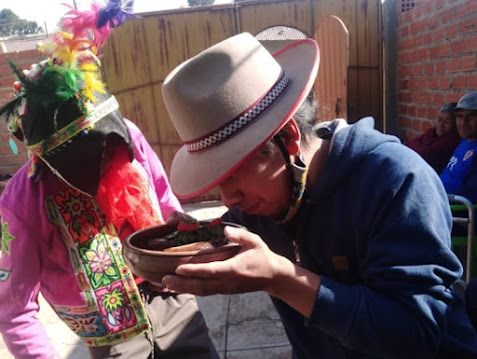AYMARÄTWA (SOY AYMARA)[1]
A lo
largo de nuestra historia, mucho se ha hablado y se habla del pueblo Aymara de
Bolivia. Desde inicios de la república fue catalogado por sus detractores como
“pueblo enfermo”, en la revolución del 52 los nacionalistas le quitaron su
identidad nombrándolo “campesino”, y en los últimos quince años, junto a los
otros pueblos indígenas del país, se lo ha considerado “reserva moral del
mundo“. Todo esto a partir de la mirada ajena, del uso instrumental de los
gobiernos y de las corrientes ideológicas de turno. Sin embargo el Aymara, cuerpo y espíritu del
altiplano andino, ha ido avanzando a paso lento, pero seguro, en la disputa de
espacios geográficos, culturales, políticos e intelectuales. De nada sirve hoy
tratar de delimitar lo Aymara, tratar de conceptualizarlo. El Aymara es un
devenir, un pueblo versátil que con trabajo y fiesta pone color y ritmo a
cualquier escenario donde se encuentre.
El
Aymara como cultura, como nación, expresa en sus distintos cuerpos, sus
distintos modos de vivir y mirar el mundo. Es en su práctica cotidiana donde
están expuestos los principios heredados de los mayores, como el Ayni y el qhip
nayra, y es en su práctica también donde estos principios dialogan con las
distintas lógicas externas. De ahí que es importante no limitarse solo a leer
sobre el pueblo aymara, sino verlo, mirarlo, sentirlo.
Roger Adan Chambi Mayta, El Alto, Bolivia.
Qullan
jaqïpxtanwa
Qullan wiñay Aymar jaqïpxtanwa.
Tutuk q’ara thayarus atipirïtanwa.
Arus saräwis taqi pachan uywirïtanwa.
Wiñay qullan jakaw jathachirïtanwa.
Urinsayat aransayat mayacht’asipxañäni.
Saräwisan jathanakap yapuchapxañäni.
Achachila, jisk’alalanakamp
aruskipapxañäni.
Aruskipt’asipxañanakasakipunirakïspawa
Aruskipañankiw taqimp suma qamañaxa.
Aruskipañankiw jakäw jathachañaxa.
Aruskipañankiw wawar thakhi yatichañaxa.
Aruskipt’asipxañanakasakipunirakïspawa.
Rubén Hilari, El Alto, Bolivia
This is Aymara
"There
are several ways you can visit El Alto. Every Sunday, buses depart from Plaza
San Francisco to see “chola” wrestlers. You can also take one of several new
teléferico lines where you’ll also zoom over their houses and neighborhoods. If
you’re lucky, you get to dance Morenada and drink beer with them in the
streets. If the timing is right, there may be an “electro-preste” where you can
go to a rave inside one of their mansions, those delightfully strange” and
“curious” buildings people call “cholets”. Returning to the city, you might
discover your teléferico has wifi so you can upload your photos to social
media. You’ll get fifty “likes” before you even arrive. But you can’t come up
with a tagline: “These homies live in Transformers; they are Transformers!” you
think to write. You try to make sense of the insensible.
How
do you relate to these portraits? They are Aymara, they work, they have
rituals, they celebrate Halloween and Todos Santos, they listen to rock,
cumbia, hiphop and Nirvana but also dance for Tata Santiago. Some speak Aymara
and some do not. Some speak English and others do not. Some live in brick
houses, others live in “transformers.” They are all transformers but not how
you might think of them to be. This is urban modernity, at the same time that
it is much more. This is Aymara."
Amy Kennemore, Tijuana, México
[1]
Estos textos acompañaron la exposición de fotografías del Proyecto Aymaratwa,
en la ciudad de El Alto y La Paz en el mes de Agosto del 2019 dirigido por Manuel Seoane.





Comentarios